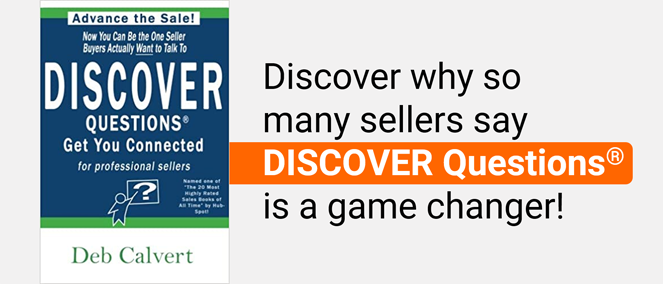4 Types of Selling Questions You're Not Asking (But Should Be)

For those who have inquired and want to improve the range of questions they are asking, here are four types of selling questions that you may not be using routinely. Each of these is highly effective in yielding information about the buyer’s needs and will also provide insight into how and why they buy.
These questions are most appropriate during the needs assessment phase of a sales process. You will find, however, that they have impact when asked during other phases in the process and also as you are interacting more routinely and casually with your buyers.
Considering the length constraints of this blog post, we will only be able to cover the basics about these four types of questions. More information is available in DISCOVER Questions®, which describes all eight types of questions to use in selling.
4 Types of Selling Questions You're Not Asking (But Should Be)
1. Solution Questions
A Solution question plants a seed for an alternative that you may later propose. It “tests the water” to get the buyer’s initial reaction and expose any potential objections you may later hear. By planting this seed early, the buyer has an opportunity to consider the alternative idea without being pressured to make a decision about it.
A Solution question should not be leading. It would NOT start out with something like “Don’t you think it would be a good idea if…” or “If I could show you a way to…” because these leading statements don’t yield the true gut reaction. They feel like a “gotcha” and cause buyers to back away.
Solution questions start like this “What experiences have you had with…” or “What consideration have you given to…” instead of sounding like a move toward a closed sale. Since this is still needs assessment, the solution should not be narrowly linked to your product. Instead, it’s a broader question about different specifications, uses, etc. of products like yours. Or it may even be related to the business itself and not to the product.
“What menu changes will you make in the new year in response to the increased competition in this area?” is an example of a Solution question. In this situation, the chef had not considered making changes to the menu, only to the marketing. This question caused him to pause and reconsider his strategy. The result? He changed the menu and marketed the changes heavily, and he was grateful to the media sales rep who asked a simple Solution question that made him think.
2. Value Questions
This question is extremely important and often left out in needs assessment and in preparing for negotiations. As a seller, it is imperative that you understand what matters most to the buyer. Responding to a need is only helpful if there is not a more urgent and pressing need that should be prioritized.
In a thorough needs assessment, then, you’d find out what is the most important need, the biggest problem, the greatest threat, the most urgent thing to address. When you deliver a solution that lines up with the highest value need or concern, that’s when you have the best chance of making a sale and winning a customer.
Value questions ask “Which is most important?” and “Tell me the single greatest need” and “How important is this?”
Knowing these answers prepares you for later negotiations on price and terms. It also enables you to invalidate objections because what is most valued trumps everything else. It is a powerful card for you to draw and play, so ask more questions to fully understand what your buyer values.
3. Example Questions
These questions are used to draw comparisons and paint contrasting pictures. No matter what you are selling, an Example question can make the use of your product feel more concrete and relatable than imagination alone.
With an example question, you’re asking for a contrast between something in the past or present and something in the future. “How does your current supply compare to your future needs?” would be a simple example. To create an even stronger mental image, though, you could ask “Describe what those traffic patterns were two years ago and how, specifically, you want to see them continue to evolve.”
With these descriptive images, you will respond by including specific details that have been shared and adding in your own products. The objective is to link your solutions with the buyer’s vision and/or past experiences.
4. Rationale Questions
Any time a decision is pending, be sure to ask “what will your decision criteria be?” And when a decision has already been made, ask “What led you to this decision?” Knowing the answers to these questions will give you a look into the decision-making process and the thought process, too, behind the decisions.
Armed with this information, you will be better prepared for decisions that are made in the future. Even if you don’t make the sale this time, you’ll know what to say or do differently the next time around.
Rationale questions have another purpose, too. They cause decision makers to stop and think about their own decisions. They sometimes reconsider decisions that have been made in haste or that don’t really add up the way they thought they would in the heat of the moment.
When asking about someone’s decision, be sure to avoid phrasing your questions with the word “why.” That word makes people feel defensive. It sounds like you are questioning their judgment rather than trying to understand their process.
Four types of questions, four types of information you may not be gathering currently.
Since knowledge is power, use these high yield questions to learn more about your buyer’s needs and you will have a much stronger platform to sell from than your products alone can provide.


